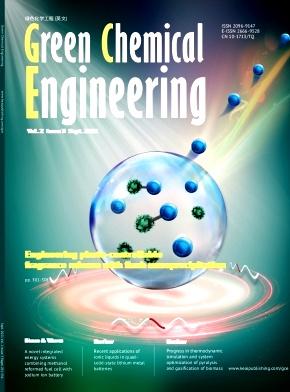Synergistic enhancement of pollutant removal from high-salt wastewater using coagulation-flotation combined process
IF 7.6
Q1 ENGINEERING, CHEMICAL
引用次数: 0
Abstract
Sufficient treatment of industrial organic wastewater with high salt and large amounts of suspended particulate matter remains a challenge worldwide. In this work, a novel coagulation-flotation combined process was developed to treat the suspended particles as well as significantly reduce organic pollutants content in the actual high-salt organic wastewater. Four typical inorganic and organic flocculants (poly aluminum chloride (PAC), poly ferric sulfate (PFS), polyacrylamide (PAM), and modified cationic starch (CS)) were selected for compounding to obtain an optimized flocculation system for high-salt wastewater. The results showed that the PAC-PAM with a 10:1 ratio in mass exhibited the best coagulation behaviors with the removal efficiency of turbidity and chemical oxygen demand (COD) being 95.33% and 9.21%, respectively, under the optimal operation conditions, and the sedimentation process of coagulant conformed to the quasi-second-order kinetics. The PAC-PAM flocs exhibited stronger netting, sweeping, and adsorption bridging capabilities, which were conducive to removing suspended particles. When the flotation was conducted after coagulation, the COD decreased significantly by 20.82%. In addition, this combined process could reduce the treatment time by 50% compared to the process with only coagulation treatment. During the flotation process, floc particles companies with hydrophobic polycyclic aromatic hydrocarbons could collide and adhere to microbubbles and be floated to the surface, resulting in an effective reduction of COD. This work could provide a novel strategy and step forward to design and optimize the pretreatment process engineering for organic high-salt wastewater.

混凝-浮选联合工艺协同强化高盐废水的污染物去除
如何充分处理含高盐和大量悬浮颗粒物的工业有机废水仍然是世界范围内的一个挑战。本文研究了一种新型混凝-浮选组合工艺,对实际高盐有机废水中的悬浮颗粒进行了处理,并显著降低了有机污染物的含量。选择4种典型的无机和有机絮凝剂(聚氯化铝(PAC)、聚硫酸铁(PFS)、聚丙烯酰胺(PAM)和改性阳离子淀粉(CS))进行复配,得到了高盐废水的最佳絮凝体系。结果表明,在最佳操作条件下,质量比为10:1的PAC-PAM表现出最佳的混凝性能,混凝剂的浊度和化学需氧量去除率分别为95.33%和9.21%,混凝剂的沉淀过程符合准二级动力学。PAC-PAM絮凝体具有较强的网状、清扫和吸附桥接能力,有利于去除悬浮颗粒。混凝后再浮选,COD显著降低20.82%。此外,与只进行混凝处理的工艺相比,该组合工艺可将处理时间缩短50%。在浮选过程中,与疏水多环芳烃相结合的絮凝颗粒会与微气泡发生碰撞并粘附,浮到表面,从而有效地降低了COD。本研究为有机高盐废水预处理工艺的设计与优化提供了新的思路和思路。
本文章由计算机程序翻译,如有差异,请以英文原文为准。
求助全文
约1分钟内获得全文
求助全文
来源期刊

Green Chemical Engineering
Process Chemistry and Technology, Catalysis, Filtration and Separation
CiteScore
11.60
自引率
0.00%
发文量
58
审稿时长
51 days
 求助内容:
求助内容: 应助结果提醒方式:
应助结果提醒方式:


